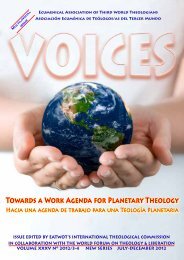voices-2013-2&3 - EATWOT's International Theological Commission
voices-2013-2&3 - EATWOT's International Theological Commission
voices-2013-2&3 - EATWOT's International Theological Commission
You also want an ePaper? Increase the reach of your titles
YUMPU automatically turns print PDFs into web optimized ePapers that Google loves.
Walking in the Garden · 93The first followers of Jesus recognized his uniqueness through hisrelationship with nature or natural objects. He was challenged to turnstones into bread, he turned water into wine, he walked on the waterand often he healed the sick in what would appear to be contraventionof natural processes. Indeed many of the incidences seem to indicateJesus’ authority over nature. Yet it appears the he needed nature andthe environment to truly show the disciples who he was. Thus the NewTestament in general and the gospels in particular are in some way rootedin the environment. They show us Jesus using and relating to natureand the environment in a positive way. Admittedly there are instanceslike the cursing of the fig tree (Mark 11: 12-14) and the sending of thepigs to their destruction.(Mark:5:1-20) where Jesus appears to have takendestructive actions.Apart from this, the incarnation itself does emphasize the importanceof the natural human world and life. God becomes human in orderto communicate God’s love and concern for human beings. However,both the Old and the New Testaments are clear on the fact that salvationis not just for human beings alone. The entire creation suffers becauseof human folly/fallenness. In Romans 8:22 Paul says that “all creationhas been groaning together till now…” The entire creation is in pain andagony because of human action. But in the same way, through the lifeand sacrifice of another human being (Jesus), the groaning and the painwill come to an end for both human and the entire creation.The Old Testament is very clear on the importance of nature andthe environment and the need for them to be tended and taken care of.It describes a very intimate relationship between human beings, theiractions in relation to the land in particular and the results of theseactions. The land motif runs all through the Old Testament. The safetyof the land as well as its productivity is intricately related to the humanbeing’s relationship to God and to the human being’s response to theCreators’ commandments. The Old Testament is therefore concerned witha relational eco-balance. It gives “guidance on how to live as a communitythat maintains right relationships with God, neighbours, strangersand the land and its creatures” 8 In this relationship even the land andthe creatures that inhabit it deserve a Sabbath rest, they must be takeninto consideration in the year of Jubilee. The land has rights and needsto rest just like the animals and plants. More importantly however is theidea that human disobedience leads to the unproductiveness of the land.(Leviticus 26:20) The land suffers when people are not in right relationshipwith God. This is the basic or foundational teaching of the OldTestament in so far as the relationship between human beings and theirenvironment is concerned.





